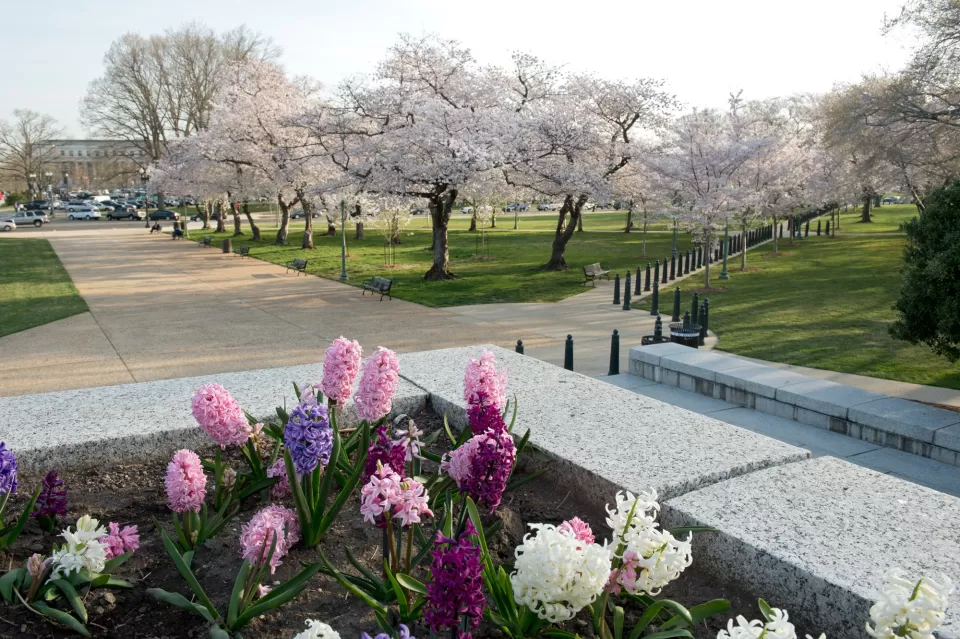As spring arrives, winter hibernation gives way to the colors, aromas and sounds of flora and fauna. This is the season when the U.S. Capitol as well as its grounds enjoy the highest number of visitors. Warmer temperatures, numerous blooming trees and flowers as well as spring break vacations are some of the key drivers of larger crowds across the Capitol campus.

What can visitors see and do in spring?
Blooms Abound
Washington, D.C.'s famous cherry blossoms herald spring, peaking around late March and early April. More than one million visitors arrive in the District every year, drawn primarily to the cherry blossom trees lining the Tidal Basin. The U.S. Capitol Grounds also offer more than 100 cherry blossom trees — both the Yoshino and Japanese Flowering varieties — for public enjoyment.

Most of the trees are found in the Upper and Lower Senate Parks. Some of the oldest and most impressive are located on the West Front of the U.S. Capitol and on the Second Street, SE, side of the Library of Congress Thomas Jefferson Building.
Magnolia, shadbush, dogwood and apple trees also adorn the U.S. Capitol Grounds with impressive and fragrant blooms. In addition, thousands of spring bulbs planted in flower beds throughout the Capitol campus sprout a riot of color, including tulips, hyacinths, crocus and daffodils.
Duck Ramps at the Capitol Reflecting Pool
Springtime in Washington, DC, wouldn't be complete without the sight of a brood of ducklings waddling behind their mother. On the U.S. Capitol Grounds, you can also watch them swim in the Capitol Reflecting Pool, which multiple mallard duck families call home.
The large limestone coping ringing the reflecting pool has the unintended side-effect of making it difficult for ducklings to climb in and out of the pool. The AOC collaborated with City Wildlife, a Washington, D.C.-based not-for-profit organization, to solve the problem. Skilled AOC staff members designed and built two duck ramps that are installed next to the coping each spring to safely and effectively assist ducks in and out of the water.
Spring Concert
Every year, the National Symphony Orchestra (NSO) performs a free Memorial Day starlight concert on the West Front lawn of the U.S. Capitol.
What does the AOC work on in spring?
Prepping and Turf

In spring, grounds crews are busy digging bulbs and prepping beds for the planting of approximately 35,000 assorted annuals. Extensive mowing, seeding and fertilizing of turf areas also takes place as well as plenty of mulching.
Tree Care
Trees are a major feature of the U.S. Capitol Grounds and continue to reflect Frederick Law Olmsted's original landscape design, a vision which drives all landscaping decisions on the grounds today.
The AOC's arborists prune trees throughout the year for their health as well as for the safety of people and property below. Spring is one of the busiest seasons for the arborists because the trees are leafed out, so our certified arborists can more accurately and effectively evaluate tree health and structure.
Tree planting on the grounds occurs during spring and fall seasons. Trees are selected based on treatment recommendations from Cultural Landscape Reports that take into account the historical period of significance for landscape preservation efforts.
Water Feature Maintenance
The smaller of the U.S. Capitol campus water features found throughout the grounds are cleaned twice a week in spring, summer and fall to remove particulate matter, maintain water flows and clean stains.
About the U.S. Capitol Grounds
The U.S. Capitol Grounds are comprised of approximately 286 acres, including the U.S. Capitol, Senate and House office buildings, the Capitol Power Plant and Union Square. The Capitol Grounds and Arboretum jurisdiction of the AOC is responsible for both the day-to-day maintenance of the U.S. Capitol Grounds and the preservation of a significant historic landscape and accredited arboretum originally designed by Frederick Law Olmsted. In addition, every aspect of caring for the Capitol campus follows rigorous environmentally sustainable practices.

For an easy and on-the-go reference to all that the U.S. Capitol Grounds have to offer, download the Capitol Grounds app to your phone. Explore the interactive map, photos, audio clips, historic details and more. Visit the Apple Store or Google Play to download the app today!








